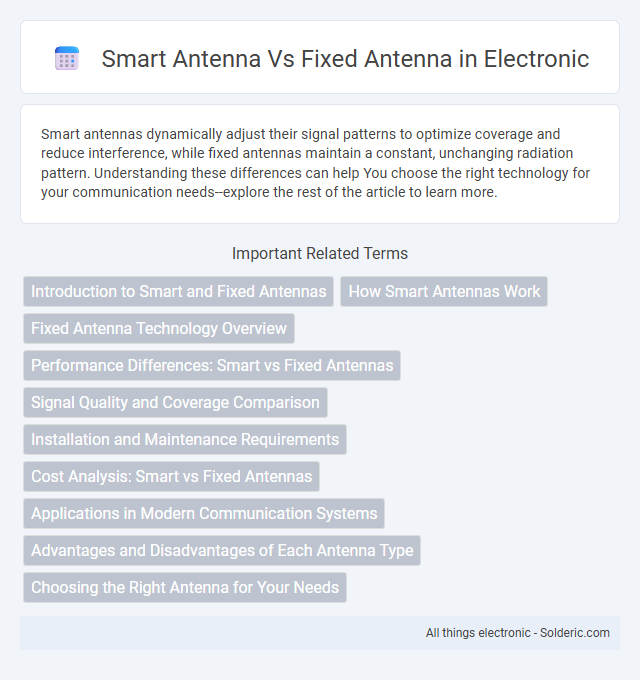Smart antennas dynamically adjust their signal patterns to optimize coverage and reduce interference, while fixed antennas maintain a constant, unchanging radiation pattern. Understanding these differences can help You choose the right technology for your communication needs--explore the rest of the article to learn more.
Comparison Table
| Feature | Smart Antenna | Fixed Antenna |
|---|---|---|
| Definition | Adaptive antenna system that dynamically adjusts beam patterns. | Static antenna with fixed beam direction and pattern. |
| Beamforming | Dynamic beamforming for optimal signal direction. | No beamforming; fixed beam orientation. |
| Interference Management | Mitigates interference by adaptive null steering. | Limited interference rejection. |
| Mobility Support | Excellent for mobile users due to adaptive patterns. | Best suited for stationary or fixed users. |
| Complexity | High complexity; requires sophisticated signal processing. | Low complexity; simpler design and deployment. |
| Cost | Higher cost due to advanced technology. | Lower cost and maintenance. |
| Application | Used in modern wireless systems: 5G, smart networks. | Common in basic wireless setups and fixed links. |
Introduction to Smart and Fixed Antennas
Smart antennas use adaptive signal processing to dynamically adjust their radiation patterns for improved performance, while fixed antennas maintain a constant radiation pattern with no real-time adjustments. Smart antenna systems optimize signal strength and reduce interference by continuously tracking signal sources, enhancing communication in wireless networks and radar applications. Fixed antennas provide reliable, stable coverage in predefined directions but lack the flexibility to adapt to changing environmental conditions or user movements.
How Smart Antennas Work
Smart antennas use advanced signal processing algorithms to dynamically adjust their radiation patterns, enhancing signal reception and transmission by focusing on specific directions. They utilize multiple antenna elements and adaptive beamforming techniques to minimize interference and optimize communication performance in real-time. This enables improved range, capacity, and reliability compared to fixed antennas, which have static radiation patterns and cannot adapt to changing signal environments.
Fixed Antenna Technology Overview
Fixed antenna technology provides reliable, stationary wireless signal transmission and reception with a set direction and coverage area, making it ideal for consistent communication needs. These antennas typically offer robust performance in environments where signal paths remain stable, unlike smart antennas, which actively adapt beamforming techniques. Your network benefits from fixed antennas through simplified installation and predictable coverage, especially in infrastructures requiring durable, long-term connectivity solutions.
Performance Differences: Smart vs Fixed Antennas
Smart antennas dynamically adjust their beam patterns to optimize signal strength, reduce interference, and enhance network capacity, resulting in superior performance compared to fixed antennas. Fixed antennas maintain a constant radiation pattern that can lead to signal degradation in changing environments and limited adaptability to interference. Your network performance benefits significantly from the adaptive capabilities of smart antennas, especially in complex or congested wireless settings.
Signal Quality and Coverage Comparison
Smart antennas dynamically adjust their beam patterns to enhance signal quality by reducing interference and focusing energy toward the intended user, resulting in improved coverage and higher data throughput. Fixed antennas maintain a constant radiation pattern that can lead to signal degradation in changing environments, offering limited coverage flexibility and susceptibility to multipath fading. This adaptability of smart antennas ensures more reliable connections and optimized coverage, particularly in dense or complex signal environments.
Installation and Maintenance Requirements
Smart antennas require more complex installation procedures involving precise calibration and integration with adaptive signal processing systems, leading to increased setup time compared to fixed antennas. Maintenance demands for smart antennas are higher due to their advanced electronics, requiring regular software updates and diagnostics to ensure optimal performance. Fixed antennas offer simpler installation and minimal maintenance, making them suitable for environments where ease of setup and low upkeep are priorities.
Cost Analysis: Smart vs Fixed Antennas
Smart antennas typically involve higher initial costs due to advanced technology and signal processing capabilities, whereas fixed antennas are generally more affordable with simpler design and installation requirements. Over time, smart antennas can offer cost savings by enhancing network capacity, reducing interference, and improving coverage, leading to lower operational expenses. Your choice depends on balancing upfront investment against potential long-term efficiency and performance benefits.
Applications in Modern Communication Systems
Smart antennas dynamically adapt their radiation patterns to enhance signal quality and capacity in applications such as 5G networks, wireless LANs, and mobile communication systems. Fixed antennas, with preset radiation patterns, are commonly used in simpler applications like broadcast radio, point-to-point microwave links, and traditional cellular base stations where directional stability is essential. Your choice between smart and fixed antennas impacts system performance, especially in environments requiring interference mitigation and spatial multiplexing.
Advantages and Disadvantages of Each Antenna Type
Smart antennas dynamically adjust their beam patterns to enhance signal quality and reduce interference, offering higher capacity and improved coverage in wireless networks. Fixed antennas provide simpler, cost-effective installation with consistent directional or omnidirectional patterns but lack adaptability to changing signal environments. Your choice depends on application requirements, balancing smart antennas' performance advantages against fixed antennas' reliability and lower complexity.
Choosing the Right Antenna for Your Needs
Smart antennas adapt dynamically to signal environments by electronically steering beams, enhancing connectivity and reducing interference, making them ideal for mobile and variable settings. Fixed antennas provide consistent, predetermined coverage with simpler installation and lower costs, suitable for static applications with stable signal requirements. Selecting between smart and fixed antennas depends on factors like mobility, coverage precision, budget constraints, and the need for real-time signal optimization.
Smart antenna vs Fixed antenna Infographic

 solderic.com
solderic.com